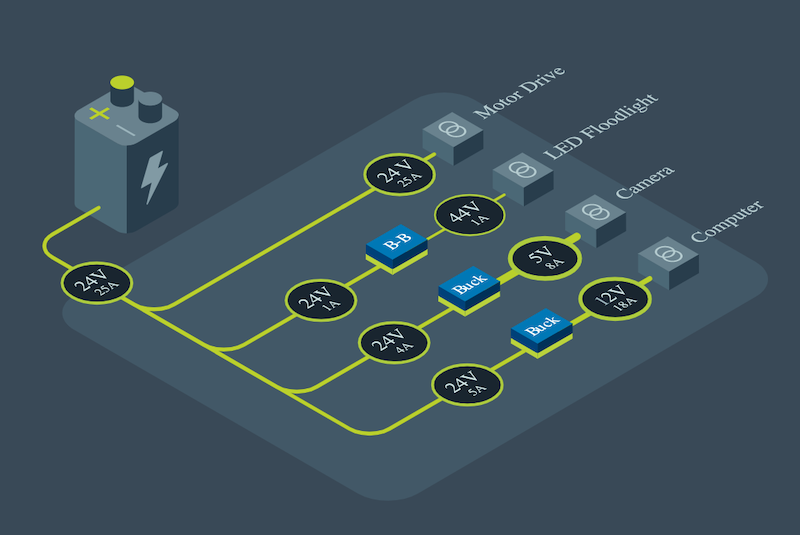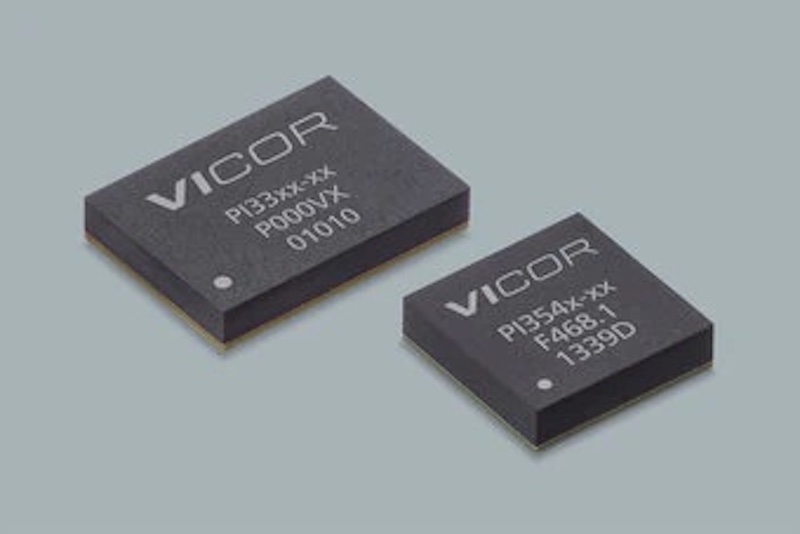Vicor delivers power conversion breakthroughs to fuel a robot revolution
OLogic incorporates advanced, integrated power modules from Vicor Power to ignite a new generation of mobile robots
Innovations in power conversion technology are enabling a transformation in robotics design.
Today’s integrated power modules are addressing the demanding size, weight, power budgets and cost efficiencies required to move robots from factory, residential and commercial applications into a vast new landscape bounded only by the imagination.
We are hitting a tipping point where robots are bringing tremendous benefits to our lives. And OLogic is a big reason for why we see their proliferation.
OLogic, a Santa Clara, California, electronics consultancy, has more than 15 years of experience helping its clientele bring robotics designs to market in both large and small volumes by providing electrical, mechanical and industrial engineering support, as well as software and firmware engineering.

This includes expertise in power electronics integration, which is a prime design consideration that determines the range, functionality and charge capacity of mobile robots.
OLogic has designed scores of robots across many industries including, agriculture, smart homes and inventory control to name a few. OLogic traces its robotics customer base to a start-up considered by many to be the progenitor of mobile robotics in Silicon Valley.
Willow Garage was noted for its ability to tie together off-the-shelf, open-source software from universities and other entities to help robots perform difficult tasks.
When the company disbanded in 2014, it triggered a diaspora of robotics software experts who subsequently founded nearly every important robotics start-up in the Bay Area. This opened new business for OLogic with companies such as Savioke, Knightscope, Fetch and Dusty Robotics.
Example robotics power delivery network: OLogic uses Vicor power modules (Buck, Buck Boosts and PRMs) in their robots because they are power-dense, efficient and easy to use.
“We use Vicor ZVS Buck Regulators everywhere on mobile robots now. I don’t ever have to think about, ‘Oh, I need five or ten amps at 12 volts, so I’m going to go build my own supply.’ I don’t ever think that way anymore,” says OLogic CEO Ted Larson.
“The real rock stars of the robot industry are the ones doing high-level software for things like machine learning or robot algorithmic task navigation,” continues Larson. “The electronics are kind of an afterthought. What happens is that people think they can get away with buying all this off-the-shelf stuff and then plug it together. It turns into a house of cards really quickly.”
Bringing power to the fore
Mobile robots have unique power challenges and require an array of power levels. Sensors, servo motors, actuators, data servers, communications systems and other devices that operate the robot have different power and power density requirements.
Some are power-hungry. Others may operate infrequently. This demands the ability to provide power quickly, cleanly and cost-effectively from a battery-power source.
“The parts we’ve been using most lately are the Vicor ZVS Buck Regulators,” Larson says. “We use them everywhere on mobile robots now. I don’t ever have to think about, ‘Oh, I need five or 10 amps at 12 volts, so I’m going to go build my own supply.’ I don’t ever think that way anymore.”

Saving time and money by automating building layout
One customer working closely with OLogic to optimize its power profile is Dusty Robotics (Dusty). Based in Mountain View, Calif., Dusty builds robot-powered tools for the modern construction workforce.
For centuries, the construction industry used two simple tools to lay out building floor plans: a tape measure and a chalk line. Even today, when architects design buildings using sophisticated 3D CAD models, the process still calls for the layout to be printed on paper, hauled onto the job site and manually transferred to the ground.
The tape measure and marker process are slow and prone to human error that impacts schedules and budgets. Errors cause rework, which typically account for ten percent of the cost of a construction project, according to Dusty.
“When plans are laid out by hand, a lot of mistakes are made, actually a lot more than the construction industry is even aware of,” says Philipp Herget, co-founder and CTO of Dusty Robotics.
“We’ve heard of cases where layout mistakes have bankrupted construction companies. We prevent mistakes from happening because everything is marked correctly – not by hand, by a robot.”
Dusty FieldPrinter is 5x faster with zero mistakes
Dusty eliminates the conventional, labor-intensive process of physically transferring building plans onto the floor with a robot programmed at the job site to automate the same task.
The Dusty FieldPrinter robot loads a digital version of the floorplan and then prints the layout on the ground for features such as walls, doors, plumbing and electrical chases. And it does so at speeds roughly five times faster than a human and to within one-sixteenth of an inch to spec.
This innovation helps the construction industry operate more like a digitized manufacturer, increasing consistency, predictability and reliability while improving working conditions for the skilled craftspeople who are at the heart of the building process.
“If you can reduce the amount of time that’s allocated in your schedule, you can speed up how quickly the building is going to be put up,” Herget said. “And the sooner the building completes, the sooner you can start collecting revenue. Time is money.”
Powering the Dusty FieldPrinter robot
Dusty’s FieldPrinter is a battery-powered mobile robot that operates for long periods in a variety of weather conditions. It includes many different electronic devices, including sensors, drive motors and motorized components, computationally-heavy processors and a printer – all of which have different operating voltage and current requirements.
This is why Dusty engaged OLogic to build the core electronics for its robot. OLogic began by using discrete power solutions. Over time, however, Vicor Corporation introduced OLogic to a modular approach to building power delivery networks (PDNs) for robots.
OLogic came to realize that they were unable to design something as operationally and thermally efficient and with the wide operating range as a Vicor power module. Additionally, Vicor modules, such as the ZVS Buck Regulator, are extremely cost-efficient given the 200 to 300 watts of power they deliver and their 97 percent efficiency.
With a long battery life and state-of-the-art power conversion technology, Dusty’s robotics innovation is helping digitize the construction industry by creating a single source of truth on the job site, based on the digital model.
Instead of the architect, general contractor and each trade partner working off of their own paper plans, everyone now builds off of the single design printed on the floor.
The ability to provide a digital layout improves coordination between these myriad partners, enabling better planning, execution and faster completion.
“Construction automation is enhancing what humans can do,” Herget says. “People used to use screwdrivers, and now they use power tools. It just makes their job a lot easier.
“Our robot-powered tools are enabling the construction industry to level up, creating better outcomes while also improving the working environment for skilled craftspeople.”

